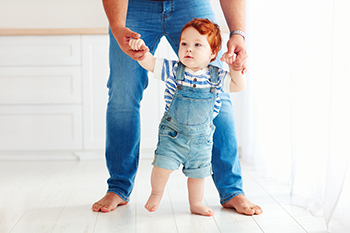
A hammertoe is when there is a deformity of the middle joint of a toe and the toe bends up or down abnormally, resembling a hammer. Hammertoe typically happens to the second, third, or fourth toes, but can also occur on the pinky toe. This condition happens from an imbalance in muscles, ligaments, and tendons in the middle joint of the toe. It can be caused by wearing shoes that do not have enough room in the toe box, foot type and structure, or injury to the foot. A hammertoe can become painful, making it difficult to walk, and it may be hard to find shoes to comfortably accommodate the abnormality. Depending on the severity of the hammertoe, stretching and strengthening exercises can help straighten the toe and minimize discomfort. Such exercises include towel toe curls, where one sits in a chair with their feet flat on a towel placed on the floor. One then can curl their toes and try to scrunch up the towel followed by extending the toes to push the scrunched towel forward. It is suggested that this be done 10 times and three times a day. Another exercise is sitting on the edge of a chair or a bed, placing the affected leg on the opposite knee, and bending the toes toward the body and then away from the body. Each position should be held for 30 to 40 seconds, and three to five sets should be done three times a day. If you are having a problem with hammertoe, it is suggested that you consult with a podiatrist who can provide additional exercises and assess the proper treatment for you.
Hammertoes can be a painful condition to live with. For more information, contact one of our podiatrists of Lovely Foot Associates, PC. Our doctors will answer any of your foot- and ankle-related questions.
Hammertoe
Hammertoe is a foot deformity that occurs due to an imbalance in the muscles, tendons, or ligaments that normally hold the toe straight. It can be caused by the type of shoes you wear, your foot structure, trauma, and certain disease processes.
Symptoms
Risk Factors
Treatment
If you have hammertoe, you should change into a more comfortable shoe that provides enough room for your toes. Exercises such as picking up marbles may strengthen and stretch your toe muscles. Nevertheless, it is important to seek assistance from a podiatrist in order to determine the severity of your hammertoe and see which treatment option will work best for you.
If you have any questions, please feel free to contact our office located in Johnstown, PA . We offer the newest diagnostic and treatment technologies for all your foot care needs.

It is beneficial for parents to pay attention to their children’s feet as they are growing. The majority of babies are born with flat feet, and the arch generally develops during their teenage years. If this fails to occur, orthotics may be needed that may help to strengthen the foot. A foot care routine can begin with washing the child’s feet, and ensuring the area between the toes is thoroughly dried. This can be followed by trimming the toenails properly, which is typically done once per week. The feet can become stronger when babies crawl barefoot while indoors, as a result of the toes gripping the floor. When it is time to walk outside, it is beneficial for the first shoes to be made with a sturdy sole and flexible materials. The feet have several thousand sweat glands, and while sweating is normal, there may be an offensive odor. It is suggested to discuss this with a podiatrist, in addition to any information you would like to know about children’s foot health.
Making sure that your children maintain good foot health is very important as they grow. If you have any questions, contact one of our podiatrists of Lovely Foot Associates, PC. Our doctors can provide the care you need to keep you pain-free and on your feet.
Keeping Children's Feet Healthy
Having healthy feet during childhood can help prevent medical problems later in life, namely in the back and legs. As children grow, their feet require different types of care. Here are some things to consider...
Although babies do not walk yet, it is still very important to take care of their feet.
Avoid putting tight shoes or socks on his or her feet.
Allow the baby to stretch and kick his or her feet to feel comfortable.
As a toddler, kids are now on the move and begin to develop differently. At this age, toddlers are getting a feel for walking, so don’t be alarmed if your toddler is unsteady or ‘walks funny’.
As your child gets older, it is important to teach them how to take care of their feet.
Show them proper hygiene to prevent infections such as fungus.
Be watchful for any pain or injury.
Have all injuries checked by a doctor as soon as possible.
Comfortable, protective shoes should always be worn, especially at play.
If you have any questions please feel free to contact our office located in Johnstown, PA . We offer the newest diagnostic and treatment technologies for all your foot and ankle needs.

Slamming and smashing our feet into the pavement as we skateboard can take its toll on the ankles and feet. The most frequent foot and ankle problems skateboarders encounter are heel bruises, flat feet, and ankle rolls. If you skateboard and want to continue doing this for some time, it is important to take care of your feet. Wash, dry, and moisturize them daily. Wear properly fitting skate shoes and only wear them for skating. When the feet are sore, take a break, rest, and even soak the feet. Skate shoes do not provide the best support in terms of padding and arch support. Extra support in the heel of skate shoes may help prevent heel bruises. A looser-fitting shoe and gel inserts might help with foot pain caused by flat feet. If you are into skateboarding and are experiencing foot problems, it is suggested that you make an appointment with a podiatrist for an evaluation and treatment options.
Sports related foot and ankle injuries require proper treatment before players can go back to their regular routines. For more information, contact one of our podiatrists of Lovely Foot Associates, PC. Our doctors can provide the care you need to keep you pain-free and on your feet.
Sports Related Foot and Ankle Injuries
Foot and ankle injuries are a common occurrence when it comes to athletes of any sport. While many athletes dismiss the initial aches and pains, the truth is that ignoring potential foot and ankle injuries can lead to serious problems. As athletes continue to place pressure and strain the area further, a mild injury can turn into something as serious as a rupture and may lead to a permanent disability. There are many factors that contribute to sports related foot and ankle injuries, which include failure to warm up properly, not providing support or wearing bad footwear. Common injuries and conditions athletes face, including:
Sports related injuries are commonly treated using the RICE method. This includes rest, applying ice to the injured area, compression and elevating the ankle. More serious sprains and injuries may require surgery, which could include arthroscopic and reconstructive surgery. Rehabilitation and therapy may also be required in order to get any recovering athlete to become fully functional again. Any unusual aches and pains an athlete sustains must be evaluated by a licensed, reputable medical professional.
If you have any questions please feel free to contact our office located in Johnstown, PA . We offer the newest diagnostic and treatment technologies for all your foot and ankle needs.

Although a pregnant woman might not initially think that they should pay attention to the health of their feet during pregnancy, there are many reasons for her to monitor the health of her feet as she carries her baby to term. First, the woman’s feet may increase in size. Second, the pregnant woman could potentially experience changes to her skin. For example, many pregnant women might experience cracked heels, where the skin around the back of the heel becomes significantly dehydrated. It is important to note that if a pregnant woman experiences continuous itching on their feet, it is suggested that they schedule an appointment with a trusted medical professional like a podiatrist. If you are pregnant, you can schedule an appointment with a podiatrist today.
Pregnant women with swollen feet can be treated with a variety of different methods that are readily available. For more information about other cures for swollen feet during pregnancy, consult with one of our podiatrists from Lovely Foot Associates, PC. Our doctors will attend to all of your foot and ankle needs.
What Foot Problems Can Arise During Pregnancy?
One problem that can occur is overpronation, which occurs when the arch of the foot flattens and tends to roll inward. This can cause pain and discomfort in your heels while you’re walking or even just standing up, trying to support your baby.
Another problem is edema, or swelling in the extremities. This often affects the feet during pregnancy but tends to occur in the later stages.
How Can I Keep My Feet Healthy During Pregnancy?
If you have any questions please feel free to contact our office located in Johnstown, PA . We offer the newest diagnostic and treatment technologies for all your foot and ankle needs.